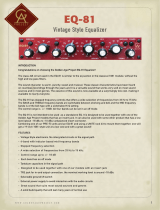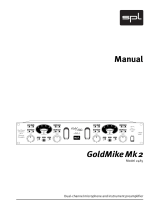Page is loading ...

WWW.GOLDENAGEPROJECT.COM I
Vintage Style Pre Amplifier
PRE-73 DLX
INTRODUCTION
Congratulations on choosing the Golden Age Project PRE-73 DLX microphone preamplifier!
The PRE-73 DLX is a one-channel vintage style microphone-, line- and instrument preamplifier. The signal path uses only discrete
components like resistors, capacitors and transistors. The line and microphone input and the line output are transformer balanced, using
three different transformers, each one optimized for its purpose.
This is the way audio components were built before integrated circuits became available. The subjective sound quality delivered by
vintage equipment is often prefered over the one delivered by modern units, a situation that is even more obvious now when music is
recorded with cleansounding digital audio equipment.
The circuit used in the PRE-73 DLX is similar to the preamp section in the classical 1073 module with a corresponding sound character
that is warm, punchy, sweet and musical. These classic characteristics have been heard on countless recordings through the years and
it is a versatile sound that works very well on most sound sources and in most genres. The essence of this sound is now available at a
surprisingly low cost, making it available to nearly everyone.
FEATURES
- Vintage Style electronics. No integrated circuits in the signal path.
- Maximum gain on the mic input is 80 dB, enough to handle passive ribbon mics with quiet sound sources.
- Gain range on the Line input: -20 to + 10 dB.
- Switchable impedance on the mic input, 1200 or 300 ohms, will change the tone of many mics.
- Switchable phantom power and absolute phase.
- A high impedance instrument input for any sound module, electric guitar or bass.
- A simple but effective 4-step LED output level meter.
- The output level control makes it possible to make fine gain adjustments and also to overload the main gain stage(s) for more character
and then lower the signal to a suitable level before the output stage.
- Combo XLR/TRS input jacks and separate output XLR and TRS jacks for flexible connections.
- Insert jack for inserting EQ´s and other units.
- External high power power supply to avoid interaction with the audio circuits and transformers.
- A solid build quality that will last many years of normal use.
The PRE-73 DLX has a number of improvement and new features compared to the PRE-73 MKII:
- Tantalum capacitors in the signal path.
- Selectable 1073-style high pass filter, 50, 80 , 160 and 300 Hz.
- Output Attenuator -7, -14, -21 and -28 dB (located after the output transformer) allows overdriving the output stage and the output
transformer for added character by lowering the output signal to a suitable level.
- The circuit board is prepared for Carnhill Mic and Line transformer and high pass inductor.
- The Insert jack can be switched in/out from the front panel. An internal jumper can select that the Insert jack always has an output
signal.
- Switchable 600 ohm Output Termination and Ground Lift on the back panel.
- Selectable Active or Passive DI input and selectable input impedance in active mode, Hi Z or 100 kohm, by internal jumpers.
- The DI signal can be selected to pass or bypass the mic input transformer by internal jumpers.
- Relays are used to control internal switching for DI input, Phantom power, Mic Low Z, Insert and Phase for shorter circuit board signal
paths. The relays are controlled by front panel switches.
- Revised gain switch for added headroom.
- Circuit board star grounding scheme.
- Revised power supply with separate regulators for the audio circuits and relay and LED circuits.

WWW.GOLDENAGEPROJECT.COM II
CIRCUIT DESCRIPTION
The signal first enters an input transformer,
one for the mic input and a one for the line
input. The primary of the mic input trans-
former has two windings that are either con-
nected in series or in parallell which results
in an input impedance of either 1200 Ohms or
300 Ohms.
The transformers are followed by two input
gain stages. For gains up to 50dB, only one of
them is being used. For gains above 50dB, the second gain stage is inserted
in the signal path. Both gain stages uses only three transistors each.
The signal then goes to the Insert jack, the High Pass filter and the Output
level potentiometer and from there on to the output stage. This stage again
only uses three transistors, the last one in the chain is a hefty 2N3055 power
transistor run in class-A mode, driving the output transformer that is followed
by the stepped output attenuator (PAD).
So, all in all, the complete signal chain only contains a maximum of nine
active elements. Compare that to the big number of transistors that are usu-
ally used in one single integrated circuit!
USING THE PRE-73 DLX
Using a preamplifier is not rocket science. Here are some points though to
help you getting the maximum out of the PRE-73 DLX:
- Connect the cable from the power adaptor to the 24V AC connector at the
back of the PRE-73 DLX. Power on the unit with the POWER switch at the
front.
- Connect your Mic and/or Line sources to the input XLR/TRS combo jacks at
the back. A Mic and Line source can be connected at the same time,
- Switching between Mic and Line input is simply done by setting the MIC/
LINE switch to one of the MIC or LINE positions.
- Connect a cable from the XLR or the TRS output jack to the next unit in the
chain. They are connected in parallel and carry the same signal. The outputs
can feed both balanced and unbalanced inputs without any problems.
- If you want the smallest amount of coloration, always set the OUTPUT level
potentiometer at or close to maximum, the PAD to 0 dB and adjust the output
level with the stepped LINE/MIC gain switch.
- If you want more character, you can do any, or both of the following:
1. Turn the OUTPUT level potentiometer counterclock-wise and increase the
gain with the LINE/MIC switch. This will drive the input gain stage(s) harder
and provoke more character from them.
2. Engage the stepped output attenuator (PAD) and again increase the gain
with the MIC/LINE switch. This will also drive the output stage and the output
transformer harder and add character.
- Engaging PAD at -14 dB is also useful if the input of the following unit has
the -10 dBu semi-professional operating level. The standard operating level of
the PRE-73 DLX is +4 dBu, the output level into a 600 ohm load will be about
1,23V when the “0” VU LED is lit when PAD is set to 0 dB.
- Instruments can be connected to the active DI TRS input at the front panel.
The DI uses a FET-buffer and has an input impedance of about 1,5 Mohm.
Press the DI switch to engage this input. The DI input works in the MIC
positions of the gain switch. Mic and Line sources at the back can remain
connected.
The output of the DI circuit is sent through the mic input transformer.
- Engage the +48V phantom power for any mic that needs it. It is a good
procedure to always disengage the phantom power and wait for about 10
seconds before unplugging the mic.
- When the LOW-Z switch is engaged, the input impedance of the Mic input
drops from 1200 Ohms to 300 Ohms. This will change the tone of many micro-
phones and will give you one more soundshaping option. It also increases the
level, which is normal.
- The PRE-73 DLX has a inductor based high pass filter with a roll off of 18 dB/
octave. This is a very useful tool to remove excess bass energy.
- The phase switch simply reverses the phase by reversing the wires from
the secondary winding of the output transformer. Reversing the phase of the
signal is useful on a number of occasions, one example is phase reversing
the the lower mic of a snare drum to make it sum in phase with the upper
mic.
- There is an unbalanced Insert jack located at the back panel where you can
insert Equalizers and other external effect units that has an operating level
of about -18 dBu. The Insert is engaged with the INSERT switch on the front
panel. Send is on “tip” and return on “ring”.
- The output transformer used in the PRE-73 DLX is made for having an ideal
load of about 600 ohm. The input impedance of most modern units is 10 kohm
or more. The PRE-73 DLX has a 600 ohm output termination switch located
at the back panel. Engaging the switch terminates the output transformer
with a resistor to bring down the load to about 600 ohms. This switch should
normally be engaged if you are connecting the PRE-73 DLX to a modern unit
but you can also choose not to engage the switch. This will lift the high end
frequency response slightly which can sometimes be a good thing.
- There is a Ground Lift switch on the back panel that lifts the internal ground
from the cabinet. If the unit is mounted in a rack together with other units and
you experience ground loop problems, try engaging it.
CUSTOMIZING THE PRE-73 DLX
There are several functions in the PRE-73 DLX that can be customized by the
user. Remove the top plate of the unit and then follow the instructions below.
Feel free to experiment with the different small tonal changes that these
options can provide.
1. To change the input impedance of the active DI input to 100 kohm
Locate the jumper JP3 just behind the DI TRS jack. Relocate the jumper so
that it connects both pins of JP3.
2. To change the DI input from an active one to a passive one
This option will feed the signal from the DI input directly to the mic input
transformer or to the first gain stage if option no 3 is used.
Locate the “DIout” socket about 10cm/4” from the front panel at the left edge of
the circuit board. Remove the connector from the socket and connect it to the
“DI pass out” socket located just behind the power switch.
Option no 1 can NOT be used at the same time as option no 2!
3. To change the DI from not passing through the mic input transformer
This option will feed the signal from the DI input directly to the gain stage.
- Locate the “DIpreXF” socket just behind the middle of the MIC and LINE XLR
inputs. Remove the connector and connect it to the “DIpostXF” socket located
in front of the mic input transformer which is the one to the left in the middle
of the circuit board.
- Locate the “DIpre” jumper located to the right of the “DIpostXF” socket.
Remove the jumper and install it at the “DIpost” jumper located to the right of
the “DIpreXF” socket.
4. To cut the output signal to the INSERT jack when insert is not activated
Locate jumper “INSout” just behind the middle of the LINE input XLR and the
INSERT TRS jack. Remove the jumper.
The circuit board of the PRE-73 DLX is prepared for Carnhill transformers and
inductors. If you did not buy your unit with these options, they can be fitted
whenever you want to do so. The work can be made by the distributor in your
area or you can do it yourself if you have soldering experience. Please note
though that the warranty will be void if work has been made on your unit by
anyone else than one of our Distributors.
The Carnhill parts can be bought in our webshop or through our Distributors.
WARRANTY
The PRE-73 DLX is built to last. But as in any electronic device, components
can break down.
There is a 1,5A, fast blow fuse located inside the unit. If the unit dies, please
check this fuse. If it has blown, replace it with a new one. You can also try with
another 24V AC adaptor if you have one available.
If this doesn´t help, or if the unit has another problem, it will need repair and
you should then contact the reseller where you bought the unit.
The warranty period is decided by the Distributor for your country. The Dis-
tributor will support Golden Age Project resellers and end users with repairs
and spare parts.
REGISTRATION
You are welcome to register your unit at: www.goldenageproject.com
---------------------------
I would like to thank you for chosing the PRE-73 DLX!
I hope it will serve you well and that it will help you in making
many great sounding recordings.
Yours,
Bo Medin
Create music
– Be happy!
/




